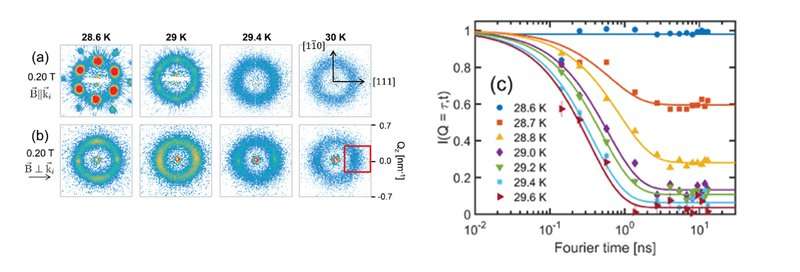Chirality is commonly found in nature, and is characterized by a reflection asymmetry. A simple example being that our left hand is the mirror opposite of our right. When this appears in the structure of atoms in a solid, it affects the way that the magnetic moments of unpaired electrons organize themselves through the relativistic spin-orbit Dzyaloshinskii-Moriya (DM) interaction. This interaction is usually weak; nevertheless, it induces qualitatively different behaviour. In chiral magnets, such as MnSi, the Dzyaloshinskii-Moriya interaction stabilises non-collinear arrangements of the magnetic moments and emergent phenomena like the topologically protected magnetic defects called skyrmions. The latter are fundamentally interesting and in the focus of theoretical and experimental studies because their small size, stability and emergent electromagnetism make them ideal candidates for spintronics applications.
It is striking that all skyrmion hosting chiral magnets, from the metallic MnSi to insulator Cu2OSeO3, exhibit the same generic phase diagram alongside other similar characteristics. A phase diagram allows one to work out exactly what phases are present at a given temperature, pressure or volume. Understanding this generic behaviour is thus of essential importance from a fundamental point of view but also for future applications.
Researchers from the Institute Laue Langevin in France, ISIS Neutron and Muon Source at the UK, Ames Lab in USA and Delft University of Technology have recently addressed this issue in their Physical Review Letters paper . By combining Small Angle Neutron Scattering and high resolution Neutron Spin Echo spectroscopy, as shown in the figure below, the team monitored the influence of a magnetic field on the chiral magnetic correlations both in space and in time. The SANS measurements were performed on the newly commissioned instrument LARMOR at ISIS Neutron and Muon Source, which is a UK-NL joint venture supported by a NWO-Groot grant of the Dutch Science foundation.

|
SANS scattering patterns obtained for a magnetic field of 0.20 T [(a) and (b)] applied parallel to the neutron beam wavevector  and perpendicular to it. Panel (c) shows the intermediate scattering function I(Q=t), with t =2π/l and l and perpendicular to it. Panel (c) shows the intermediate scattering function I(Q=t), with t =2π/l and l the pitch of the helix, at a magnetic field of 0.24 T illustrating the abrupt change, within 0.2 K, associated with the first order transition. Credit: C. Pappas et al. Phys. Rev. Lett. 119, 047203 (2017) DOI:10.1103/PhysRevLett.119.047203 the pitch of the helix, at a magnetic field of 0.24 T illustrating the abrupt change, within 0.2 K, associated with the first order transition. Credit: C. Pappas et al. Phys. Rev. Lett. 119, 047203 (2017) DOI:10.1103/PhysRevLett.119.047203
|
The results reveal that the twisted, helical conical or skyrmionic, long range magnetic order disappears abruptly with increasing temperature, as a first order phase transition, also under magnetic fields. The origin of this abrupt change is not clear and cannot only be attributed to fluctuations as was assumed so far. The experimental findings from neutron scattering thus challenge established approaches to chiral magnetism calling for additional theoretical work to understand its subtleties.
Further investigations at LARMOR as a function of the orientation of the crystallographic lattice with respect to the magnetic field should help elucidate the interplay between orientation and the first order phase transition in chiral magnets.
Author: Katia Pappas, Lars Bannenberg
Further Information
The full research paper is: “Magnetic Fluctuations, Precursor Phenomena, and Phase Transition in MnSi under a Magnetic Field", C. Pappas et al, Physical Review Letters 119, 047203 (2017) DOI: 10.1103/PhysRevLett.119.047203
“The influence of a magnetic field on chiral magnetic correlations" can be read here.
See here for further information on the LARMOR instrument at ISIS Neutron and Muon Source.
